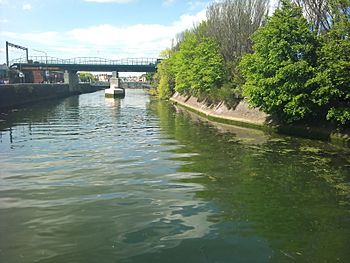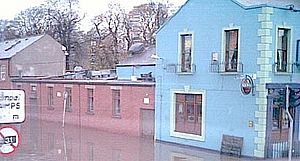River Tolka facts for kids
Quick facts for kids River TolkaIrish: An Tulcha |
|
|---|---|
 |
|
| Physical characteristics | |
| Main source | County Meath, near Dunshaughlin |
| River mouth | Dublin Bay between western Clontarf and East Wall |
The River Tolka (Irish: An Tulcha, meaning "the flood") is an important river in Ireland. It flows from County Meath, through Fingal, and into Dublin city. The Tolka is one of Dublin's three main rivers, along with the Liffey and the Dodder. It is the second largest river in Dublin by the amount of water it carries.
Contents
The River's Journey
The River Tolka starts in County Meath, near Dunshaughlin. It flows past Dunboyne, where it meets the Castle Stream. Then, at Clonee, it is joined by the Clonee Stream. From there, the river enters County Dublin.
The Tolka continues its journey through areas like Damastown, Mulhuddart, and Blanchardstown. It then flows through Ashtown and the southern parts of Finglas. Next, it reaches the north Dublin areas of Glasnevin and Drumcondra. Here, it comes very close to the Royal Canal. Finally, the river reaches Dublin Bay between East Wall and Clontarf.
Streams Joining the Tolka
Many smaller streams flow into the River Tolka. The first big one is the Castle Stream at Dunboyne. Within Dublin city, at least 14 other streams join the river.
Some of these streams include the East and West Pinkeen Streams. There is also the Scribblestown Stream, which you can see from Abbotstown. The Finglas River and the Claremont Stream also join the Tolka. Near the Botanic Gardens, the Cemetery Drain flows into the river. Other streams like the Hamstead Stream and one from St. Patrick's Teacher Training College also add water to the Tolka.
The last few streams connect to the part of the Tolka that is affected by tides. These waterways can be a mix of natural streams and city drainage pipes.
Wad River Connections
The Wad River system, which comes from north Ballymun, is connected to the Tolka. It links up with the Claremont Stream. The Wad River Diversion also flows along Ballymun Road. The Wad River usually flows into the sea at Clontarf, close to where the Tolka meets the sea.
Parks and Green Spaces Along the Tolka
As the River Tolka flows through Dublin, it passes through many beautiful parks and green areas.
It first goes through the Tolka Valley Linear Park near Blanchardstown. Then, it flows along the southern edge of the Tolka Valley Park. Here, a stream feeds a pond where you can see many birds like swans, ducks, and herons. There is also a large pitch and putt course next to the river.
The river then flows past the green areas of Glasnevin Woods and Violet Hill. It forms the northern border of Glasnevin Cemetery. Next, it reaches the Botanic Gardens. The river runs along the northern edge of the gardens, except for the Rose Gardens, which are on the other side of a bridge. After passing Glasnevin village, the Tolka flows into Griffith Park. It is a main feature of this park.
After Drumcondra village, the river runs behind houses and green spaces like the Archbishop's Palace. It then reaches Ballybough. Near Fairview, the river passes one last green space, Fairview Park. Finally, it turns to meet the sea between East Wall and western Clontarf.
Flooding of the Tolka
The River Tolka does not flood very often, but when it does, it can be severe. Unlike some rivers that flood quickly, the Tolka's water levels rise slowly over time.
Some major floods happened in 1954 and 2002, which were the most serious. In November 2002, the flooding caused a lot of damage to homes near the river. After this, a lot of work was done to improve the river's flood defences. This included making the river deeper and wider in some places, like Glasnevin Woods and Drumcondra Bridge.
Experts found that the 2002 flood happened because of heavy rain over several days. The ground was already very wet, and then more heavy rain fell for about two days. These conditions are perfect for a big flood on the Tolka.
Animals in the River Tolka
The River Tolka is home to various animals, showing its improving health.
In 2011, it was exciting news that salmon had returned to the Tolka to lay their eggs. This was the first time in over 100 years! In 2013, a survey found that otters were living along the river. This is a good sign because otters need clean water and plenty of fish to survive.
You can also often see kingfishers, bats, and grey herons near the river. The Tolka also has many small wild brown trout. The local angling club adds more trout a few times a year for fishing competitions.


